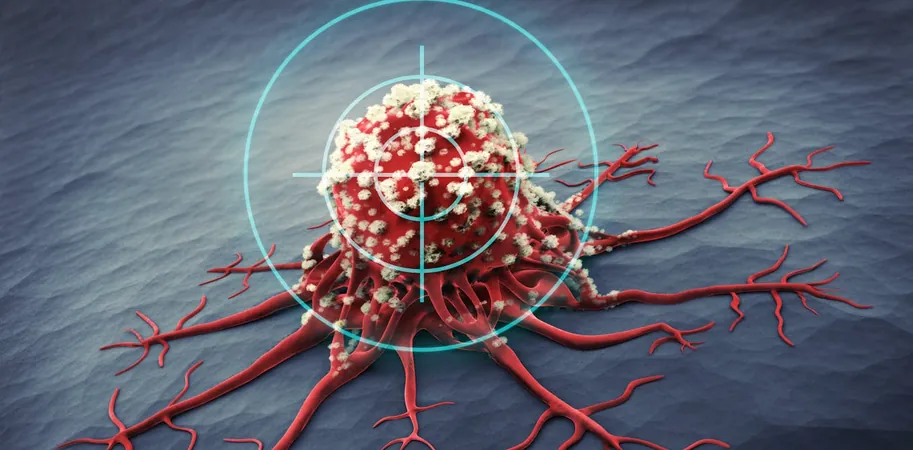
Revolutionary Microbeam Radiation Therapy: A Game-Changer in Cancer Treatment?
2025-01-15
Author: John Tan
Introduction
In the battle against cancer, traditional radiotherapy has long been a stalwart, offering a means to directly target malignant tumors. However, this method often comes at a cost, resulting in unintended damage to surrounding healthy tissues and leading to numerous side effects, creating a pressing need for innovative alternatives.
What is Microbeam Radiation Therapy?
Enter microbeam radiation therapy (MRT), a groundbreaking approach researchers are meticulously developing that harnesses extremely narrow beams of X-rays. This promising technique may not only match the effectiveness of conventional radiotherapy but also significantly reduce associated complications.
Historical Context
The origins of microbeam therapy can be traced back to the 1960s when researchers first began examining cosmic radiation. However, it wasn’t until the 1980s that scientists started to realize its potential in oncological applications. While current studies are limited to preclinical models involving animals, results have been strikingly positive, demonstrating substantial efficacy across various cancer types with distinct advantages over traditional radiotherapy.
How MRT Works
Unlike conventional radiotherapy that broadly applies radiation across tumors, potentially damaging adjacent healthy tissue, microbeam radiation therapy employs narrow beams—each thinner than a human hair—delivered in tightly spaced, rapid bursts. This results in a unique "comb-like" pattern, alternating between zones of high radiation (peaks) and low radiation (valleys). Although normal tissues could still receive some exposure, they tend to sustain less damage when compared to broader radiation approaches.
The Dose-Volume Effect
The effectiveness of MRT is supported by a principle known as the "dose-volume effect," which indicates that minimizing the volume of healthy tissue receiving radiation enhances its resilience to damage. Meanwhile, tumors, with their impaired ability to repair damage, remain vulnerable to this targeted assault.
Importance of Precision in Treatment
One of the most essential characteristics of MRT is its rapid delivery method. Given that even minor movements—like those caused by breathing—can disrupt the finely tuned microbeam pattern, precision in treatment administration is critical.
Promising Outcomes from Animal Studies
Preclinical trials have unveiled MRT's potential to significantly decelerate cancer growth, primarily by hampering the tumor’s ability to repair itself afterward. Studies with animal models have also confirmed MRT's effectiveness against a diverse range of tumors, including those in the central nervous system, breast, and skin. Intriguingly, because of the central nervous system’s tolerance to microbeams, researchers are exploring MRT’s use in curbing brain overactivity in conditions such as epilepsy.
Advantages for Sensitive Areas
MRT's targeted approach could be especially advantageous for sensitive areas like the brain, where traditional radiotherapy often leads to long-term neurocognitive effects, including memory loss. Given that children with developing brains are particularly susceptible to radiation damage, microbeam therapy may be a breakthrough solution for treating pediatric brain tumors and central nervous system malignancies.
Unique Mechanism of Action
Interestingly, the ultra-high-speed delivery of radiation depletes oxygen levels within cells, temporarily creating a low-oxygen environment that fortifies healthy cells against radiation. Tumor cells, frequently found in similarly low-oxygen zones, remain vulnerable under this treatment.
The Road Ahead for Microbeam Radiation Therapy
Despite the optimism surrounding MRT, it is crucial to note that this revolutionary therapy is still in the experimental phase and has not yet transitioned to human clinical applications. The need for advanced facilities, such as synchrotrons, crucial for generating desirable microbeams, presents a significant hurdle. These facilities, although critical for current research, are costly and not routinely applicable in everyday clinical settings.
Future Directions
Fortunately, efforts are underway to develop more compact sources capable of producing microbeams suitable for use in hospitals, signaling progress toward practical applications.
Conclusion
As research deepens and technology advances, scientists are diligently working to uncover the underlying radiobiological effects of MRT and how it might be effectively combined with existing treatments. Only by addressing these questions can we safely transition microbeam radiation therapy into patient care. With each stride made in understanding and application, the prospect of deploying such precisely targeted radiation against cancer grows ever closer—a testament to how innovative approaches like microbeam radiation therapy could profoundly reshape cancer treatment protocols for the future. Don’t miss out on the potential of this revolutionary therapy!




 Brasil (PT)
Brasil (PT)
 Canada (EN)
Canada (EN)
 Chile (ES)
Chile (ES)
 Česko (CS)
Česko (CS)
 대한민국 (KO)
대한민국 (KO)
 España (ES)
España (ES)
 France (FR)
France (FR)
 Hong Kong (EN)
Hong Kong (EN)
 Italia (IT)
Italia (IT)
 日本 (JA)
日本 (JA)
 Magyarország (HU)
Magyarország (HU)
 Norge (NO)
Norge (NO)
 Polska (PL)
Polska (PL)
 Schweiz (DE)
Schweiz (DE)
 Singapore (EN)
Singapore (EN)
 Sverige (SV)
Sverige (SV)
 Suomi (FI)
Suomi (FI)
 Türkiye (TR)
Türkiye (TR)
 الإمارات العربية المتحدة (AR)
الإمارات العربية المتحدة (AR)